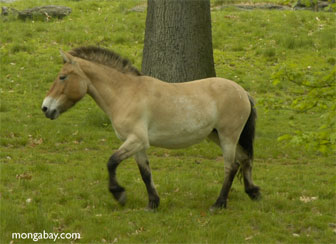Man may be responsible for prehistoric extinctions
University of East Anglia
May 5, 2006
New research suggests that prehistoric horses in Alaska may have been hunted into extinction by man, rather than doomed by climate change as previously thought.
The study is published this week in Proceedings of the National Academy of Sciences (PNAS).
Until now the leading theory said that the demise of wild horses occurred during a period of climate cooling long before the extinction of mammoths and the arrival of humans from Asia.
The researchers — including Andrew Solow of Woods Hole Oceanographic Institute, US, David Roberts of the Royal Botanic Garden, and Kew and Karen Robbirt of the University of East Anglia — found that the incompleteness of the fossil record combined with uncertainties in dating fossil remains from the Pleistocene period means that horses may have survived until the arrival of humans.
“This research is exciting because it throws open the debate as to whether climate change or over-hunting may have led to the extinction of pre-historic horses in North America,” said Karen Robbirt, a plant biologist with the University of East Anglia.
Through their research, the scientists aim to develop a more accurate timetable, and eventually a cause, for the extinction of Pleistocene horses and mammoths. To this end, the paper “develops a new statistical method to help resolve the inherent problems associated with dating fossils from the Pleistocene period” according to a statement from the University of East Anglia.
 Mongolian horse. Image by R. Butler |
|
The Pleistocene period refers to an era 1.81 million to 11,550 years ago characterized by “extensive glaciation of the northern hemisphere and the evolution of modern man around 100,000 years ago.” At maximum glacial extent as much as 30% of the Earth’s surface was covered by ice.
The end of the Pleistocene period was marked by large-scale extinctions of animals around the world, especially in North America. While no one is yet certain what caused the demise of these mammals — which included such wild beasts as giant sloths, mammoths, sabertooth cats, and oversized horses and rhinos— one of the leading theories argues that habitat fragmentation, caused by global climate change, split species into small populations, making them more vulnerable to extinction by human hunters. Models suggest that by merely killing off 2 percent of the mammoth population every year, the entire species would be doomed to eventual extinction some three or four centuries down the road. These natural (climate change) and unnatural (human) influences working in concert may have condemned to extinction some of the most magnificent creatures ever seen by man. Today humankind are facing a similar scenario, only this time we may be responsible for both factors, the global climate change and the overexploitation of species and habitats.
RELATED ARTICLES
Past mass extinction events linked to climate change
Most mass extinctions were caused by gradual climate change rather than catastrophic asteroid impacts says Peter Ward, a paleontologist at the University of Washington in Seattle, in an upcoming article in New Scientist magazine. Ward says that of the five major extinctions have occurred in the past 500 million years—the Ordovician, the Devonian, the Permian, the Triassic and the Cretaceous—, only one, the Cretaceous event which wiped out the dinosaurs, was likely caused by an asteroid impact. “It’s such a simple idea that for 20 years we just assumed the same was true for all extinctions,” says Ward. He believes that climate change has been responsible for most of the great extinctions.
Humans ate giant lemurs to extinction Madagascar’s first inhabitants probably hunted the island’s largest animals to extinction according to research published in the November issue of the Journal of Human Evolution. Madagascar, an island a little larger than California, has long been known for its unusual creatures and staggering biodiversity. The island is home to such evolutionary oddities as lemurs, a group of primates endemic to the island; brilliantly colored lizards including geckos and chameleons; tenrecs, spiny hedgehog-like creatures; and the fossa, a carnivorous animal that looks like a cross between a puma and a dog but is closely related to the mongoose.
This article used quotes and press materials from the University of East Anglia